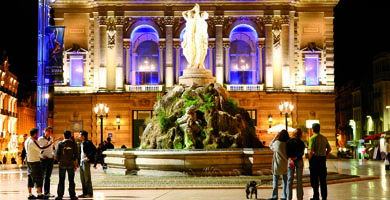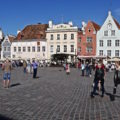Cyprus: the Island of the Gods' Timeless Appeal
Anchored at the far eastern edge of the Mediterranean, where cultures have collided and coalesced for centuries, the island of Cyprus sits at the crossroads of Europe and the Middle East, evoking elements of both, but ultimately standing apart as its own unique destination. Lacking the bling or notoriety of a Sardinia or Capri, Cyprus instead welcomes with a mild Mediterranean climate, miles of coastline and sheltering bays, inviting villages, and countless hillsides bristling with vineyards. A coveted prize for successive waves of conquerors over the centuries, Cyprus remains a desirable destination for travelers seeking to get off the beaten path and find some of the most economical travel options in the region.
One of the 3,500 square-mile-island’s first tourists was a Trojan War hero who, having failed in his duty to keep his brother alive during the conflict, was exiled by his father, the king of a Greek city state. Searching the seas for somewhere he could call home, the warrior landed in Cyprus, fell in love with its beauty, and never left. Greek soldiers, traders, and settlers followed, giving the island its deep roots in Hellenic culture and language. Next however, came successive waves of Phoenicians, Egyptians, Persians, Assyrians, Romans, Crusaders, French, Venetians, Turks and finally the Brits. Maybe you’re next.
Before you go, it’s important to note that in Cyprus, all this history and myth aren’t just backstory, but actually play a leading role in the experience here. Cults devoted to Aphrodite, the goddess of love, and Apollo, god of arts and music, flourished here and related sites include her mythic birthplace and temples devoted to Apollo, where raucous ceremonies centuries ago might have marked history’s first raves.
By contrast, you’ll first touch down at the country’s newly expanded airport in Larnaka. Highlighting the country’s increasing modernization, Larnaka International Airport is now three times larger and features gleaming new terminals just opened in November of last year. But your trip really begins in Nicosia (Lefkosia in Greek), the capital and heart of the country in more ways than one. Dating back to the Bronze Age, centrally-located Nicosia is a place of contrasts. It’s where a stoic barrier divides Turkish-controlled Northern Cyprus from the Greek-dominated south, and where pretty shopgirls hawk knock-off designer clothes beneath the shadows of Medieval parapets. It’s also where you can dine on righteous taverna specialties like meze─meat or fish dishes flavored with local herbs and olives─and quaff Commandaria, a local fortified wine that was the drink of choice of the Crusaders.
In the old city, make sure to walk Laiki Geitonia, a warren of twisting lanes with shops, boutiques, and galleries selling everything from Cyprus national team soccer jerseys and handcrafted-leather goods, to one of the true cultural treasures of the island: Byzantine-style icon paintings. The best place to purchase high-quality icons is at the respected Diachroniki Gallery, where you can find images painted by the most renowned artists in Cyprus. Prices start at approximately $600. To see priceless icons dating back over a thousand years, as well as ancient frescoes and mosaics, visit the Byzantine Museum in the heart of old Nicosia. Also recommended is the national Cyprus Museum with its impressive collection of artifacts dating back 8,000 years, including Bronze Age jewelry, Greek marble statues and Roman mosaics.
A great photo opportunity nearby is brooding Famagusta Gate, part of massive stone bulwarks surrounding the old city that are a relic of the Venetians ill-fated attempt to keep the Turks at bay.
The sun, sea, and evocative landscape of temples and antiquities beckon next in Pafos, a UNESCO World Heritage site. (But before taking to the road, decide if you want to rent a car or hire a driver–roads and signage are good on the island, but driving is Brit-style, on the left). En route, you’ll pass some of the most spectacular archaeological sites on the island. On a wind-swept hill overlooking the Mediterranean, Kourion features room-sized Greek and Roman mosaics that once adorned villas of the ruling class. Adjacent is a 3,000-seat Greco-Roman amphitheater dating to the 2nd century B.C. which is still used to host special events.
Make sure to also stop at the Sanctuary of Apollo Hylates, now a collection of columns and worn balustrades, which once attracted pilgrims from all over the Classical world. Later, stop for lunch and feast on fresh fish meze chased by a cold Keo beer at the aptly-named Panoramic View taverna. The coast below provides a priceless vista, including the massive rock known as Petra Tou Romiou, where legend holds mighty Aphrodite made her Earthly debut.
Hollywood’s deities, including Tom Hanks, Leo DiCaprio and Emma Thompson, have all found refuge nearby on the isolated Akamas Peninsula. Here at the Anassa Hotel, a cluster of whitewashed villas recreate the feeling of a traditional Mediterranean village─should there happen to be any five-star iterations. Filled with streaming light, amphora and columns, each room─ranging from studios and suites to a two-story villa with a private pool─boast breathtaking views of the cobalt blue sea. Dining at Anassa is equally memorable with four restaurants ranging from formal Helios to intimate Basiliko. You should also make time to experience the Thalassa Spa. Picking-up on the ancient tradition of Roman baths known here for thousands of years, Thalassa pampers with thalasso therapy, body wraps, and aromatherapy utilizing native botanicals and prestige lines such as Organic Pharmacy.
Buffed, rested, and infused with enough knowledge of myth and legend to rewrite a Joseph Campbell tome, finish your Cyprus sojourn with some mindless fun worthy of a true Sybarite. Ayia Napa, on the southeastern coast, brings a little bit of Ibiza to this end of the Med. This is where youngish Swedes, Brits and Europeans come to find their own bit of bacchanalia under the hot sun lolling on the area’s seductive white sand beaches.
Here you can relive your rave days from the relative safety of the other side of the planet in places like the newly-opened Babylon Club and Club Ice, which throws legendary foam and popcorn parties for an intimate crowd of up to 1,200 glow-stick waving revelers. The Cliff Bar attracts an older, well-heeled set of guests and locals more interested in fine vintages than shooters. It’s also conveniently located in the Grecian Park Hotel, a five-star property just outside of Ayia Napa with a popular spa and beachside location. When it’s time to recover, the talcum sands of Nissi Beach are the best lay-out in town. Making your way home, you’ll certainly be able to say you had an epic time in the playground of the gods.
[simpleflickr set=”72157614732600706″ /]
Latest posts by Eric Hiss
- Water Warriors Hit The Beach In SOUTHERN CALIFORNIA - September 4, 2015
- BORA BORA'S Ultimate Beach Party - November 17, 2014
- Surf in Style in LAGUNA NIGUEL - June 26, 2014







wow it’s really a beautiful place!!!!
Wonderful story for a beautiful country.
Love the photos!
Thank you,
Tasoula
I love Cyprus – it is the best vacation I have EVER had! The food, weather, and people were great.
definitely made me want to go
Love the shot of the Greek priest on the cell phone!
As an expat here, yes a beautiful island of course, but the Island needs to be stricter on pollution to keep the natural beauty.